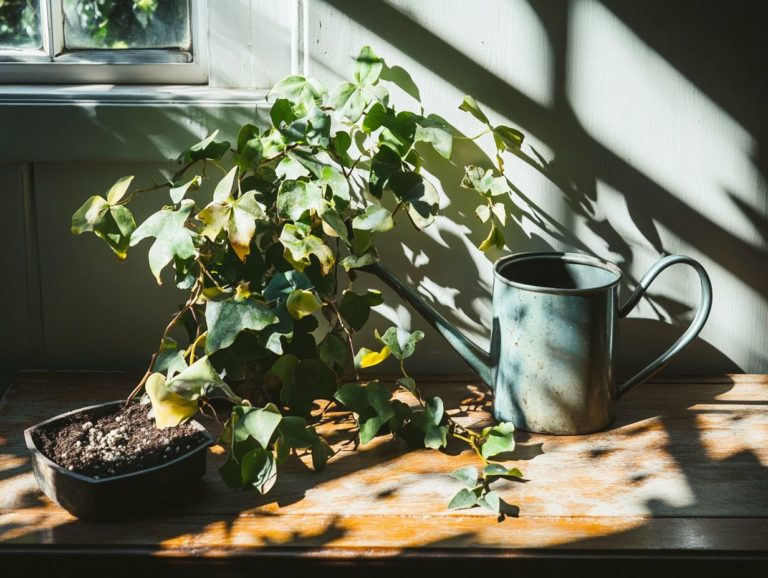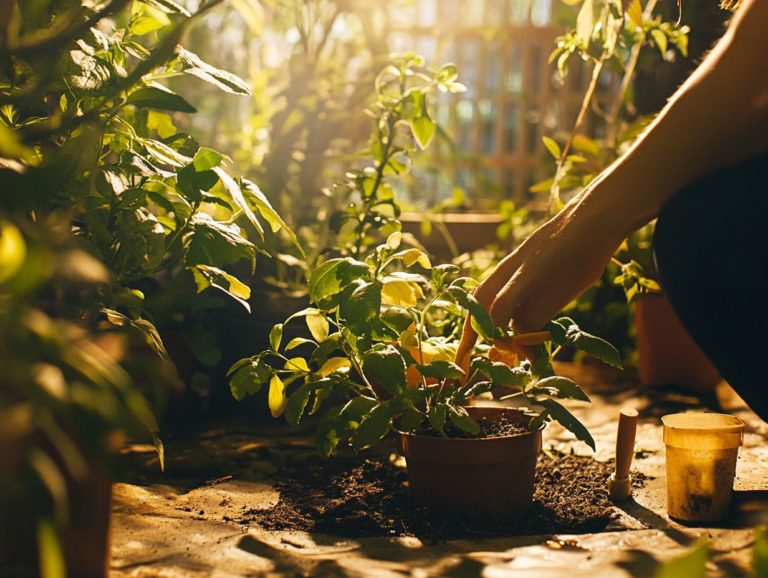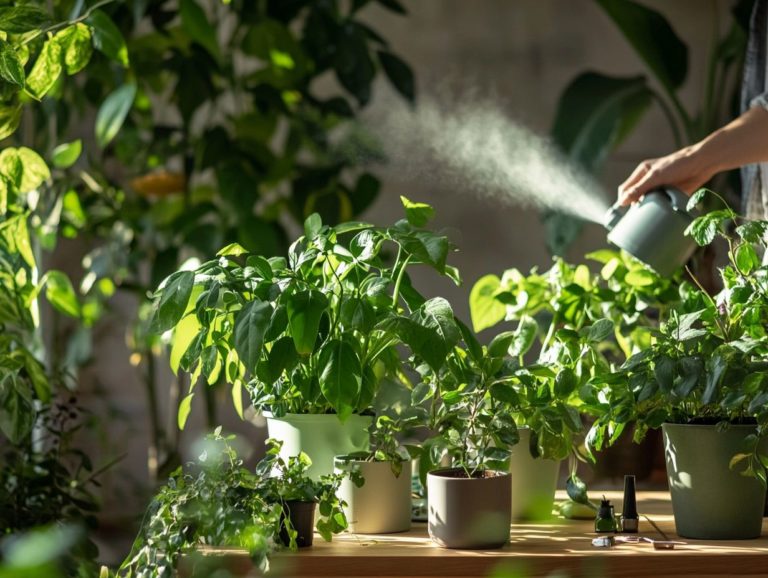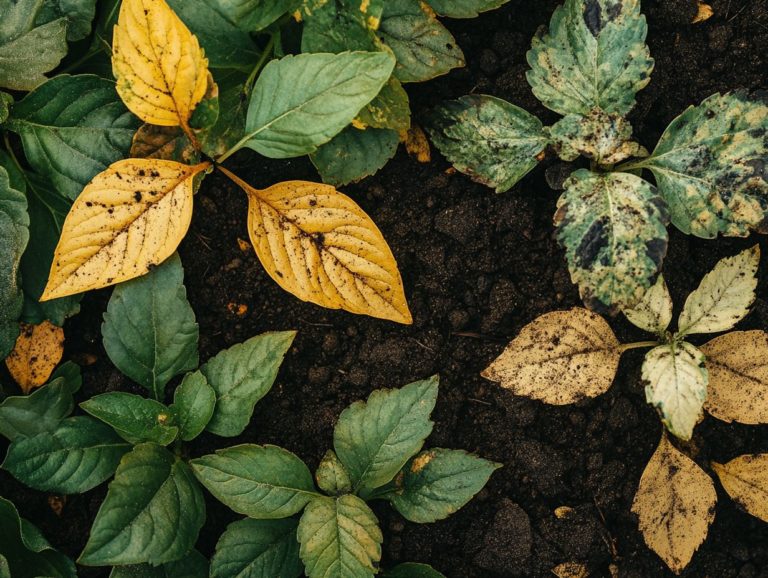Understanding Root Health in Houseplants
Healthy roots are the essential foundation for thriving houseplants. Unfortunately, they often go overlooked until problems arise.
Dive into this article to discover the crucial role roots play in a plant’s overall wellness. You’ll learn to recognize the signs of root distress and understand the common causes behind root issues.
You’ll also uncover best practices for maintaining root health and the direct link between robust roots and vibrant growth.
By the end, you’ll be equipped with the knowledge and tools to nurture your plants from the ground up.
Contents
- Key Takeaways:
- The Importance of Root Health in Houseplants
- Signs of Unhealthy Roots
- Causes of Root Issues
- Maintaining Healthy Roots
- Root Health and Plant Growth
- Frequently Asked Questions
- What is root health and why is it important for houseplants?
- How can I tell if my houseplant’s roots are healthy?
- What are some common issues that can affect root health in houseplants?
- How can I promote and maintain good root health in my houseplants?
- Can root health affect the appearance of my houseplant?
- What should I do if I notice my houseplant’s roots are unhealthy?
Key Takeaways:

- Proper root health is crucial for the overall health and growth of houseplants.
- Signs of unhealthy roots include wilting, stunted growth, and discoloration. These can be addressed through proper care and identification of root problems.
- Common causes of root issues include overwatering, poor drainage, and pest infestations. Following best practices for root care is vital to maintaining healthy roots.
The Importance of Root Health in Houseplants
Root health is paramount for the vitality of your houseplants. It directly impacts their growth and overall well-being.
Healthy roots not only anchor your plants securely in the soil but also enhance their ability to absorb essential nutrients and water, allowing them to flourish.
Environmental factors, like the quality of water and the type of soil you choose, play significant roles in nurturing roots. Understanding the water needs of each plant can prevent root rot, a disease caused by too much water.
To ensure proper drainage, regularly inspect the root systems of your plants. This is vital for effective plant care.
Why Roots Matter
Roots are fundamental to the overall health of your houseplants. They act as the primary system for nutrient absorption and securely anchor the plant in its soil.
Roots stabilize your plants against environmental challenges like wind and heavy rain. They also work with beneficial soil creatures and organic matter.
The type of soil you choose sandy, loamy, or clay-rich can greatly influence root development. The texture and drainage capabilities of the soil affect both moisture retention and oxygen availability.
Varying moisture levels can significantly impact root health. While some plants thrive in damp conditions, others may struggle in overly wet soil, risking rot. By understanding these dynamics, you can enhance your plants’ growth and vitality, ensuring they thrive under your care.
Signs of Unhealthy Roots
Identifying unhealthy roots in your houseplants is crucial for effective plant care. Symptoms like wilting leaves and yellowing foliage often signal root rot or other underlying issues that need your attention.
Identifying and Addressing Root Problems

To effectively tackle root problems, start with a comprehensive root inspection. Use tools like a moisture meter to evaluate soil moisture levels. This initial step is crucial for identifying root rot and understanding the moisture content surrounding the roots.
Visual inspections are equally important. Signs like yellowing leaves or stunted growth may indicate deeper issues. Once you’ve pinpointed root rot, treatment options are available, including the careful use of pruning shears to remove infected roots. Remember to sterilize your tools to prevent further contamination.
Adopting cultural practices such as improving drainage and avoiding over-watering can significantly reduce future risks, fostering a healthier environment for root development.
Causes of Root Issues
Grasping the underlying causes of root issues is essential for achieving thriving houseplants. Among the most common offenders are overwatering and inadequate potting soil. Both can lead to root rot a condition where roots decay due to excessive moisture and fungal diseases that can harm the plant’s health, such as Phytophthora and Rhizoctonia.
Common Factors Affecting Root Health
Several factors can profoundly impact root health, including your plant’s specific water needs and the quality of the potting medium. The efficiency of the drainage system within the container also plays a crucial role.
To foster optimal root development, it’s essential to understand how these elements interact. Environmental conditions, such as humidity and temperature, are important in determining how well roots absorb moisture.
Maintaining a consistent moisture level is key. It prevents the soil from becoming too saturated or too dry, both of which can induce root stress. Effective watering practices involve regularly checking soil moisture and adjusting your watering schedule based on the seasons, following expert gardening tips.
Selecting a potting mix with excellent aeration properties perhaps one that includes perlite or vermiculite, materials that help keep the soil light and well-draining can promote drainage. Using pots equipped with sufficient drainage holes ensures that water doesn’t accumulate.
By carefully managing these factors, you’ll be amazed at how much stronger your plants can grow!
Maintaining Healthy Roots
Don’t wait! Maintaining healthy roots is essential for vibrant, thriving houseplants. By implementing best practices like regular repotting, ensuring proper drainage, and selecting high-quality potting soil you can significantly enhance root health and prevent root rot.
These steps will support your plants growth and contribute to their overall well-being.
Best Practices for Root Care
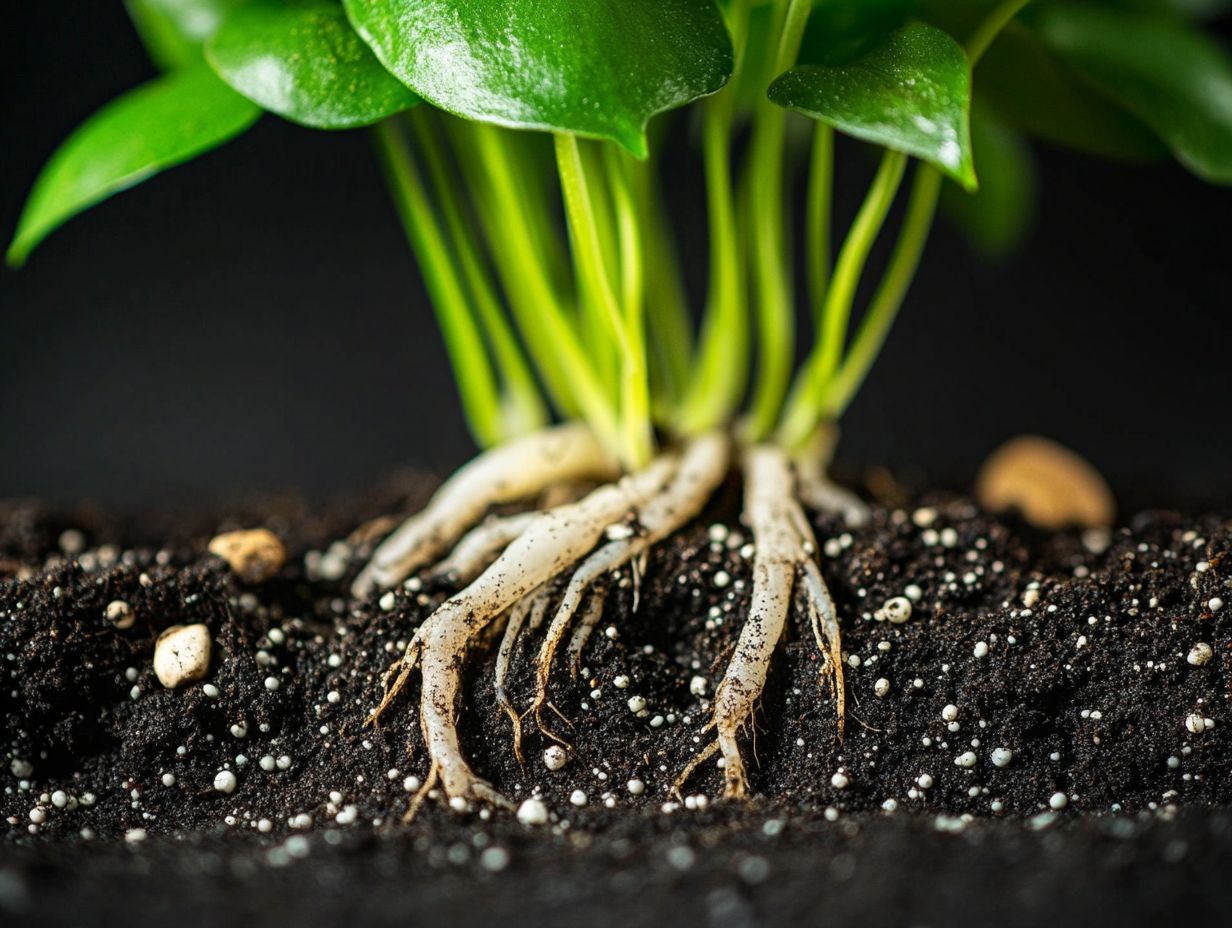
To ensure your plants enjoy robust root health, embrace best practices, including proper drainage techniques and selecting quality potting soil that nurtures a thriving root system while reducing the risks of root rot disease.
Incorporating these strategies will not only boost growth but also significantly reduce the likelihood of common issues like root rot. It s crucial to choose potting soil that offers the right balance of aeration and moisture retention, creating the perfect environment for healthy roots.
Utilizing proper drainage methods such as opting for pots with drainage holes and adding materials like perlite or vermiculite can vastly improve water flow and prevent complications. When managing your roots, don’t hesitate to use pruning shears to trim away any damaged or overcrowded roots. This encourages new growth and helps maintain a balanced root structure.
By following these practical tips, you can cultivate your plants successfully from the ground up.
Root Health and Plant Growth
The connection between root health and plant growth is significant. Healthy roots are vital for efficient nutrient uptake and effective water absorption, ensuring your plants thrive to their fullest potential.
This foundation sets the stage for lush foliage and vigorous growth, promoting the overall vitality of the plant.
The Connection Between Roots and Overall Plant Health
The connection between roots and overall plant health is critical. The state of the root system profoundly influences your plant’s ability to thrive in its environment.
Healthy roots are the cornerstone of effective nutrient absorption. They promote vigorous growth and enhance resistance to pests and diseases. When roots are well-nourished and properly aerated, your plants can efficiently access water and essential minerals. This results in lush foliage and vibrant blooms.
Conversely, neglecting root care can lead to stunted growth and heightened susceptibility to infections. This underscores the importance of proactive plant care strategies, such as monitoring soil moisture and ensuring proper drainage.
Environmental factors like temperature, light exposure, and soil composition are crucial for maintaining healthy roots. They ultimately enhance your plant s resilience and overall vitality while addressing the needs of feeder roots.
Frequently Asked Questions
What is root health and why is it important for houseplants?
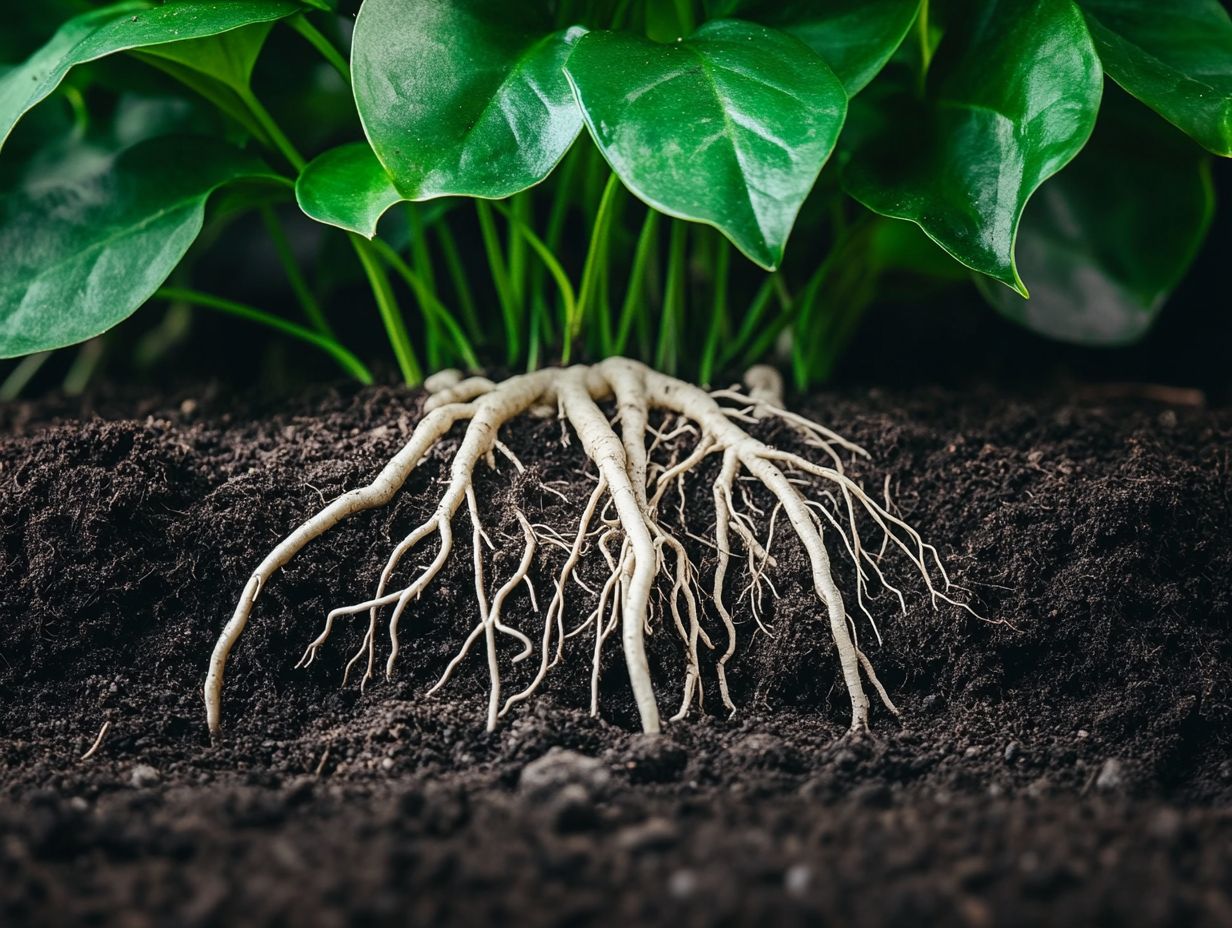
Root health refers to the overall well-being and condition of a plant’s root system. The roots are responsible for absorbing water and nutrients, providing stability for the plant, and facilitating growth. Therefore, having healthy roots is crucial for the overall health and survival of houseplants.
How can I tell if my houseplant’s roots are healthy?
One way to check for root health is to gently remove the plant from its pot and inspect the root system. Healthy roots should be white or light-colored, firm to the touch, and evenly distributed throughout the soil. Any signs of discoloration, mushiness, or lack of roots can indicate a problem with root health.
What are some common issues that can affect root health in houseplants?
Overwatering, underwatering, and using the wrong type of soil can all negatively impact root health. Additionally, pests and diseases can damage or kill a plant’s roots if left untreated.
How can I promote and maintain good root health in my houseplants?
Proper watering and using well-draining potting medium are key factors in maintaining root health. It’s also important to regularly check for symptoms of pests and diseases and address any issues promptly. Providing adequate sunlight and proper fertilization can promote healthy root growth. Using a moisture meter can help monitor soil moisture levels to meet your plant’s water requirements.
Can root health affect the appearance of my houseplant?
Absolutely! Healthy roots are necessary for a plant to thrive and produce vibrant foliage. If a plant’s roots are struggling, it may show signs of wilting, yellowing leaves, or stunted growth. Keeping a close eye on root health can help prevent these issues and keep your houseplants looking their best.
What should I do if I notice my houseplant’s roots are unhealthy?
If you think your plant’s roots are struggling, act quickly! Repot the plant in fresh, well-draining soil and trim off any damaged or dead roots. Adjust your watering and fertilization routine as needed to promote root recovery. If the problem persists, consult a plant specialist for further advice.
Keep your houseplants happy and healthy! Start monitoring their root health today!
In summary, maintaining root health is vital for your plants’ overall well-being. By being proactive and attentive, you can enjoy a thriving, beautiful indoor garden.



